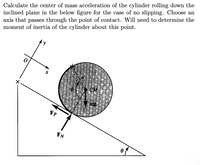
Elements Of Electromagnetics
7th Edition
ISBN: 9780190698614
Author: Sadiku, Matthew N. O.
Publisher: Oxford University Press
expand_more
expand_more
format_list_bulleted
Concept explainers
Question

Transcribed Image Text:Calculate the center of mass acceleration of the cylinder rolling down the
inclined plane in the below figure for the case of no slipping. Choose an
axis that passes through the point of contact. Will need to determine the
moment of inertia of the cylinder about this point.
FP
FN
Expert Solution
This question has been solved!
Explore an expertly crafted, step-by-step solution for a thorough understanding of key concepts.
This is a popular solution
Trending nowThis is a popular solution!
Step by stepSolved in 3 steps with 2 images

Knowledge Booster
Learn more about
Need a deep-dive on the concept behind this application? Look no further. Learn more about this topic, mechanical-engineering and related others by exploring similar questions and additional content below.Similar questions
- he assembly consists of a disk having a mass of 5 kg and slender rods ABand DC which have a mass of 2 kg/m. If L = 0.6 m, determine the moment of inertia and radius of gyration of the assembly about an axis perpendicular to the page and passing through point O. Also, find the position of the center of mass Gin relation to O. Please explain stepsarrow_forwardThe rod AB is non-uniform with a radius of gyration of 4.00 ft with respect to a horizontal axis through the center of mass G. It weighs 161 lb. At the moment shown the rod has a counterclockwise angular velocity of 3.00 rad/sec, and the spring is compressed by 2.00 ft. Calculate the force constant of the spring that will reduce the angular velocity of the rod to 1.50 rad/sec when it reaches the horizontal position. Assume the blocks A and B are weightless.arrow_forwardThe following figure shows a top view of a spinning, cylindrical gyroscope wheel. The pivot is at O, and the mass of the axle is negligible. Use ?=2.9cm and ?=3cm. a. As seen from above, is the precession clockwise or counterclockwise? b. If the gyroscope precesses at 1.7 revolution per second, what is the angular speed of the wheel in revolution per minute? Insert your answer correct up to at least a third decimal place.arrow_forward
- Determine the rotational inertia of the device shown below. R = 0.50 m, r = 0.2 m, the mass of the box is 30 kg. When Fapp= 176 N, the box has an upward acceleration of 0.8 m/s2. Use g = 9.8 N/kg.arrow_forwardEdit question Calculate the radius of gyration for the system of two tubes and a seat that form a swing with respect to the axis A shown in the figure. The dimensions of this system are shown in the figure below.The tubes have a mass of 19 kg/m. This means that each meter of tube has a mass of 19. Tubes can be thought of as slender rods.The seat has a mass of 23 kg and can be considered as a thin plate. Note that several views of the swing are offered so that you can better understand which is the reference axis A and the necessary dimensions. As you solve the problem, take into account that you are going to fill a table with the following format. It must be filled with the corresponding units.arrow_forwardThe spool of cable has a mass of m and a radius of gyration of k. The tension in the cable T is a function of time t, when this in seconds. Neglect the mass of the unwound cable, and assume it is always at a constant radius. a.) What is the moment of Inertia of the spool? b.) What is the angular acceleration of the wheel at t (Use + for the ccw direction)? c.) How quickly is the cable being pulled at time t (Use + for to the right) in m/s? do T d₁ 0 = 60° Variable do d₂ h kc m T TEL Value 1m 0.5 m 2.25 m 0.77 m 100 kg 30t³ +77t N 1.81 s 1352 + 0) N harrow_forward
arrow_back_ios
arrow_forward_ios
Recommended textbooks for you
 Elements Of ElectromagneticsMechanical EngineeringISBN:9780190698614Author:Sadiku, Matthew N. O.Publisher:Oxford University Press
Elements Of ElectromagneticsMechanical EngineeringISBN:9780190698614Author:Sadiku, Matthew N. O.Publisher:Oxford University Press Mechanics of Materials (10th Edition)Mechanical EngineeringISBN:9780134319650Author:Russell C. HibbelerPublisher:PEARSON
Mechanics of Materials (10th Edition)Mechanical EngineeringISBN:9780134319650Author:Russell C. HibbelerPublisher:PEARSON Thermodynamics: An Engineering ApproachMechanical EngineeringISBN:9781259822674Author:Yunus A. Cengel Dr., Michael A. BolesPublisher:McGraw-Hill Education
Thermodynamics: An Engineering ApproachMechanical EngineeringISBN:9781259822674Author:Yunus A. Cengel Dr., Michael A. BolesPublisher:McGraw-Hill Education Control Systems EngineeringMechanical EngineeringISBN:9781118170519Author:Norman S. NisePublisher:WILEY
Control Systems EngineeringMechanical EngineeringISBN:9781118170519Author:Norman S. NisePublisher:WILEY Mechanics of Materials (MindTap Course List)Mechanical EngineeringISBN:9781337093347Author:Barry J. Goodno, James M. GerePublisher:Cengage Learning
Mechanics of Materials (MindTap Course List)Mechanical EngineeringISBN:9781337093347Author:Barry J. Goodno, James M. GerePublisher:Cengage Learning Engineering Mechanics: StaticsMechanical EngineeringISBN:9781118807330Author:James L. Meriam, L. G. Kraige, J. N. BoltonPublisher:WILEY
Engineering Mechanics: StaticsMechanical EngineeringISBN:9781118807330Author:James L. Meriam, L. G. Kraige, J. N. BoltonPublisher:WILEY

Elements Of Electromagnetics
Mechanical Engineering
ISBN:9780190698614
Author:Sadiku, Matthew N. O.
Publisher:Oxford University Press

Mechanics of Materials (10th Edition)
Mechanical Engineering
ISBN:9780134319650
Author:Russell C. Hibbeler
Publisher:PEARSON

Thermodynamics: An Engineering Approach
Mechanical Engineering
ISBN:9781259822674
Author:Yunus A. Cengel Dr., Michael A. Boles
Publisher:McGraw-Hill Education

Control Systems Engineering
Mechanical Engineering
ISBN:9781118170519
Author:Norman S. Nise
Publisher:WILEY

Mechanics of Materials (MindTap Course List)
Mechanical Engineering
ISBN:9781337093347
Author:Barry J. Goodno, James M. Gere
Publisher:Cengage Learning

Engineering Mechanics: Statics
Mechanical Engineering
ISBN:9781118807330
Author:James L. Meriam, L. G. Kraige, J. N. Bolton
Publisher:WILEY